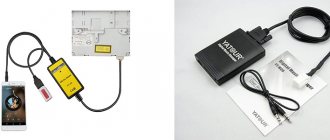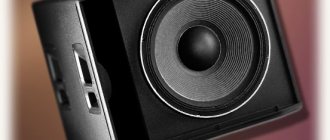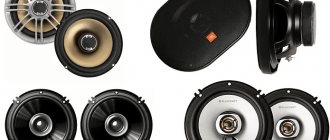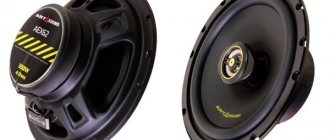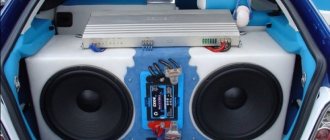Why do you need a car audio amplifier?
The built-in amplifier of the radio does not always correspond to the characteristics declared by the manufacturer. Average power indicators do not exceed 18-20 watts. Even the maximum figures of 55 watts, which are indicated on the front panel of the audio system (4x55), are nothing more than a successful marketing ploy, and are never achieved under operating conditions. This causes the low quality of sound reproduced in the car. The noise level in the cabin blocks the sound of music, and when you try to make it a little louder, distortions appear, a decrease in sound amplitude and other things that are unpleasant for the ear. That's why people who value good sound in their car are advised to connect an amplifier to their existing car audio system.
Which manufacturer's speakers to choose?
When purchasing acoustics for your car, you should immediately determine which parameter will be your priority.
If preference is given to trusted brands, you should pay attention to manufacturers such as Sony, Pioneer, Kenwood and JVC. In most cases, they produce decent sound quality and are reliable.
The main disadvantage of speakers of these brands is their high cost.
If you are a perfectionist or a fan of classical music, then avoid budget systems and speakers from manufacturers such as Mystery, Supra, CallCell and Fusion. You will not be able to achieve high-quality and beautiful sound in your car with them. However, more expensive models of these brands are distinguished by acceptable sound quality and uninterrupted operation for several years.
We recommend choosing speakers from brands such as DLS, MTX, JBL, Focal, Hertz, Rockford Fosgate, Magnat, Boston Acoustic, Alpine, Blaupunkt, Nakamichi, Lightning Audio, Infinity or Morel. Judging by user reviews, the models of these brands have a good price-quality ratio.
Finally, we would like to emphasize that illiterate installation of speakers can negate all the advantages of even the most productive and expensive radio. Therefore, to get truly high-quality sound, it is best to install an audio system in your car in specialized auto repair shops, where you can count on the help of real professionals.
How to choose an amplifier
They differ in the number (1-, 2-, 3-, 4-, 5-, 6-channel) channels and class (AB and D). Class AB - analog devices with high power ratings, but an insignificant efficiency factor that would correspond to the power reserve. Class D - digital devices with high efficiency levels and a large power reserve, but they cannot always boast of excellent quality. 1-channel devices Monoblocks, as they are also called, are used for subwoofers, as they operate at a low load (1-2 Ohms). They are most often presented in class D, since for a subwoofer it is not the quality that is important, but the power of the sound. They are equipped with a developed low-frequency crossover and an external volume control. 2-channel They are used to connect a pair of speakers or connect a subwoofer using a bridge connection. If the power allows, they can also be connected via a coil to the car amplifier channel. 3-channel Today they are used extremely rarely, as they have been replaced by four-channel devices. The third channel was used to connect the subwoofer. 4-channel The most popular and widespread all over the world. They are used to amplify power in various ways: connecting to four speakers, two speakers and one subwoofer, or two subwoofers. The versatility of their application determines their demand. 5-channel Used to increase the power of four channels of front and side acoustics and one subwoofer. This is an economical option that includes amplification of all components of the audio system in the car, and its compact dimensions can significantly save space. 6-channel They are used extremely rarely, as they are not in demand by ordinary consumers who prefer simpler car audio systems.
Overview of species
The 21st century has undoubtedly contributed to increased technological diversity. Nowadays, speaker amplifiers come in a wide variety of designs, but it is possible to create a convenient classification of such equipment.
Thus, there are three main types of such equipment.
- Pre-amplifier. If, for example, a device such as a simple microphone works in poor quality, then an amplifier will help it process the audio, improve the information data and add the necessary power.
- Final amplifier. This device performs its immediate duties, that is, it amplifies the sound. It is this kind of equipment that can be seen in recording studios, along with all other professional devices and installations.
- Integrated amplifier. It is some kind of hybrid of the above. This system is the most common and in demand among users. Like any other combined installation, it provides a slightly lower quality of sound reproduction in comparison with concert amplifiers, but at the same time it significantly benefits in its versatility and affordable price.
The amplifier for speakers is also differentiated according to the type of signal received.
The analog unit operates from electrical oscillations coming from the player and increases their power parameters many times over. To connect such an amplifier to digital broadcasting, you will need special converters.
Digital, as the name suggests, transforms incoming digital audio signals into analog, thereby making them understandable to speakers.
Depending on the type of amplifier, transistors, that is, those elements that increase the signal power inside the device itself, can function differently. Their typical division according to this characteristic is so diverse that one can only focus on the most significant differences.
Without going into technical details, let us draw your attention to the technical and operational parameters that are characteristic of equipment of different categories
- Classes A, B, AB, H and their various derivatives. Despite the fact that equipment in the presented categories may differ in the degree and period of opening of transistors to conduct current, the principle of their operation is approximately the same. The main problem with any speakers is that at the initial stage of passing current, nonlinear distortions of the output signal often occur. Any class A amplifiers are aimed at neutralizing them. This leads to a decrease in efficiency and serious overheating of the equipment. Accordingly, group A amplifiers are recognized as the most accurate; they are less susceptible to interference than any other, but have lower performance parameters.
- Class D amplifiers. Such equipment passes electric current immediately, as a result, the presence of any nonlinear distortions is minimized. Strictly speaking, this version of amplifiers is the opposite of the first group. They significantly improve in efficiency, but perform poorly when reproducing the frequency range, this is especially noticeable when it comes to higher frequencies. It makes sense to use such amplifiers in cars.
Whether or not to install a capacitor
The capacitor is widely used on cars of any configuration, as it improves the properties of the car amplifier and the sound quality of the subwoofer, which sometimes, during signal amplification, can consume more energy than the battery can provide at that time. Even the thickness of the subwoofer amplifier wires cannot prevent failures in its operation. You should also take into account the load on the car's electrical system when the air conditioning is running in the summer or heating in the winter. In this case, the battery is unable to instantly respond to the rate of current consumption. Capacitors will help eliminate these negative effects. This, in fact, is nothing more than a large-volume electrolytic capacitor, which is connected in parallel to the amplifier's power circuit. It reacts instantly to increased current demand and quickly charges to release a new dose of current to the amplifier.
Peculiarities
All acoustic systems for professional and household use use a special device - a sound amplifier. It is necessary to ensure loud, clear and high-quality playback of audio recordings without any distortion or interference.
This device converts the incoming electrical signal into a stronger one by increasing the current power. The power amplifier is made both in the form of a separate device that is part of the acoustic installation, and in the form of a built-in component. The installation includes the following structural elements:
- direct audio amplifier - connects to the source of audio recordings, may differ in higher or lower output voltage;
- power supply - this element is responsible for converting the incoming electrical flow into current with higher voltage parameters;
- output stage - consists of a group of transistors that ensure the conversion of high voltage from the power supply into the correct signal form, which is transmitted to the sound output device;
- adjustment module - this component is present only in stand-alone amplifiers; it determines fine-tuning of the output sound quality.
The operating principle of any sound amplifier comes down to several processes.
- From a standard electrical network of 220 volts, current is supplied to the power supply, after which it is transformed into a constant value.
- A sound amplifier for speaker systems receives a signal through the inputs from any device connected to them, for example, a player, and changes its amplitude using a constantly flowing current. In this case, the sound wavelength remains unchanged.
- The signal with amplified power is transmitted to the output device, that is, the speakers, through which it is reproduced in a clearer and improved sound.
How to connect an amplifier
Choosing and buying amplifiers is only half the battle. It is very important to choose the right place to install it as they get hot. Therefore, it is necessary to provide them with natural ventilation. Some models have a built-in ventilation system and this is very convenient. Most often they are installed in the luggage compartment of a car, behind the back of the rear seat, under a seat, on the rear parcel shelf, or on a false panel in the corner of the trunk. It is very important to correctly configure the operation of the entire car audio system, consisting of a capacitor, amplifier, speakers, subwoofer and car radio. The specialist carrying out this work must have experience and knowledge of tuning, since the final sound quality depends on it. So, we came to the conclusion that an amplifier in a car is a necessary thing both for lovers of a calm and measured drive, and for connoisseurs of high-quality sound, volume and drive. The capacitor will ensure uninterrupted power supply to the system, and nothing will overshadow the moments of enjoying music. Now you know how to correctly select and install an amplifier in your car.
DIY connection
If you decide to connect the amplifier to the car radio yourself according to the diagram, familiarize yourself with the installation process. It makes no difference where the device will be installed - under the car seat, next to it or on the rear parcel shelf. The main thing is to adhere to a certain scheme of actions.
Tools and materials
You will need:
- wires;
- screwdriver;
- stationery knife.
Stranded wire
Flat blade screwdriver
Stationery knife
Algorithm of actions
It is necessary to connect the interconnect cables from the car radio to the device. If the device is four-channel, then two pairs of wires will be needed, if the device is two-channel, then one pair is enough. The next step is the installation of power cables to the device, we are talking about positive and negative wires. The best option is to install directly to the positive and negative terminals of the battery. To simplify the task, you can connect the negative cable directly to the car body, because its body is the mass, so you don’t have to pull the wire to the battery. As for the control cable, it connects directly to the car radio without problems. If the amplifier is mounted in the luggage compartment, then the cables should be laid where other wiring is located. Today, many cars are equipped with special channels for electrics, which will isolate the cables from external influences. Pay attention to cable connections. In order to do everything correctly and the music is of high quality, and the signal passes through without loss, acoustic terminals are used. One of the important conditions is that the contact of the cables must be reliable, but if it is not possible to purchase such terminals, then the connection can be made without them. Regarding the capacitor, its installation is optional. You need to connect a capacitor if the wires you are using leave much to be desired and their connection is not strong. The final stage will be the installation of acoustic wiring from the device to the car's music speakers or subwoofer. If you confuse the polarity of the wires, nothing bad will happen. After installing the device, you need to listen to how well the speakers play; if you hear that the sound is repeating and playing with noise, then the polarity must be changed
What is important in this case is reliable contact of all elements of the speaker system so that the wires do not become disconnected arbitrarily as a result of vibrations.
1. Install the amplifier itself.
2. Find a place to lay the wiring.
3. Lay out the wires.
Sensitivity, resonant frequency and sound character of car acoustics
Of course, when choosing speakers, size and their power are important, but sensitivity (sound pressure), resonant frequency (Fs) and overall sound quality (Qts) are key.
In this case, the following statements are true:
- The higher the sound pressure (sensitivity) parameter, the better. An indicator in the range of 92–94 is considered optimal.
- The recommended value of the resonant frequency should vary between 60–75, and the lower this parameter, the deeper the bass the car owner will receive in the end.
- The Qts should ideally be greater than 0.6, especially if the speakers are installed in car doors.
To make the car “play”
If you don’t take into account premium brands like Lexus, BMW, Range Rover, Mercedes, then the standard music from the factory is nonsense, good only for listening to the radio or lullabies for children.
Standard acoustics in public sector and middle-class cars have a narrow frequency range, a large sound stage, and are generally made according to the principle of “this is it and that’s okay.” Nobody bothers with creating a stage, surround sound, vibration and noise insulation of doors, or selection of components. As a rule, with a normal head unit, the music already at two-thirds of the volume begins to distort and wheeze. Some tools are completely lost, resulting in a mess.
General view
Ratio between amplifier and speaker power
In the old days, a lot depended on the power of the amplifier, and buyers relied on this parameter when making their choice. The price of the acoustics also depended on the power of the amplifier (see How to connect an amplifier and subwoofer to a car radio: you are your own master), its quality. Technologies began to develop and power eventually ceased to be a fundamental criterion. Playback quality comes first.
Why do you need power?
Amplifier to speaker ratio
Below is information that will be useful for every connoisseur of good sound to know:
- The power of the amplifier directly affects the volume, but not only that. The device itself and its power cannot directly influence the volume of sound emitted by the speakers. And this component depends on the ratio of acoustics and amplifier.
- The acoustic component known to everyone today, called “sensitivity,” is measured in decibels and indicates what sound pressure a certain acoustic system can develop (at a distance of 1 meter from it).
- The usual sensitivity of modern speaker systems ranges from 83-105 decibels. A person during a quiet conversation emits a sound of 60 dB, loud rock music - 110 dB, but 120 dB or more already creates a real situation of complete loss of hearing for a person.
It is very important to measure the ratio of acoustics and amplifier at a distance of one meter, and not more or less. For example, a 3 W device paired with 105 dB acoustics will sound as loud as a 384 W amplifier with an acoustic sensitivity of 84 dB. When choosing this element of the system, you need to remember one more important rule: it must always have a power reserve. This will deprive the user of the inconvenient situation when it is necessary to turn the volume knob to maximum, as a result of which, on some amplifiers, quite large sound distortions can be observed
If you imagine a rotator in the form of a clock (many modern devices do this), then a comfortable volume level should be achieved when rotating the rotary until 10-11 o’clock. All acoustic models can be divided into 2 large groups. This is a group where 4-ohm systems are collected and a group where 8-ohm systems are collected.
Acoustics 6 ohm amplifier 8 ohm
For owners of 8-ohm acoustics, the ratio of parameters will not be particularly important. In this case, it is much better to concentrate your attention on the sound. On the contrary, those with 4-ohm systems would be wise to look at amplifiers that can double the power as the ohm drops. For example, such a device should output 100 W at 8 Ohms, and 200 W at 4 Ohms. At the same time, we must also not forget about the sound quality of the amplifier.
Acoustics for marcantz amplifier
- Typically, 4-ohm acoustics are chosen by connoisseurs of bass and rhythmic music. When playing low frequencies, 8 ohm acoustics make the bass a little vague and indistinct.
- On the other hand, among amplifiers that do not double the power, there are much more devices worthy of attention in terms of build quality.
- All types of acoustics can also be divided into simple and complex, from the point of view of their relationship with the amplifier. This depends not only on the above factors, but also on such components as the size of the speakers, their design, etc. Complex types of speaker systems complicate the process of controlling the speakers for the device (see How to choose speakers for a car radio on your own). As you know, a good amplifier not only instantly sets the speaker cone in motion, but is also obliged to stop it when the signal stops.
Amplifier 8 ohm acoustics 6 ohm
Damping factor is the name given to an amplifier's ability to drive speaker cones. In more powerful devices, this parameter is usually better and has good current output.
In short, choosing the right amplifier is a real art.



